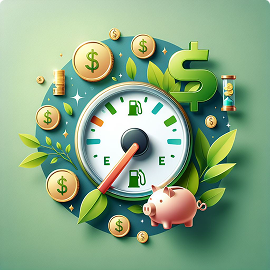
In the U.S., truck drivers can drive up to 11 hours in a 14-hour workday according to Hours of Service (HOS) regulations. This article will explain these rules, including how many hours can a truck driver drive daily, weekly, and rest period limits work to prevent driver fatigue and ensure safety.
Table Of Content
- Service Regulations: Daily Driving Limits for Truck Drivers
- Understanding the 14-Hour Workday
- Hours of Service: Weekly On-Duty Limits
- Required Rest Breaks
- The 34-Hour Restart Rule
- Sleeper Berth Provision
- Exemptions to HOS Regulations
- Importance of Compliance with HOS Rules
- Using Electronic Logging Devices (ELDs) for Compliance
- Time Management Tips for Truck Drivers
- Summary
- Frequently Asked Questions
Key Takeaways
- Truck drivers are allowed to drive a maximum of 11 hours within a 14-hour work shift, following a mandatory 8-hour rest period to ensure safety.
- HOS regulations include a 70-hour weekly limit over an 8-day period to prevent cumulative fatigue, with specific exemptions for certain conditions.
- The use of Electronic Logging Devices (ELDs) is critical for compliance with HOS regulations, allowing accurate tracking of driving and rest periods.
Service Regulations: Daily Driving Limits for Truck Drivers

One of the cornerstones of the Hours of Service (HOS) regulations is the daily driving limit. According to these hours of service rules, truck drivers are allowed to drive for a maximum of 11 hours within a 14-hour work shift. This 11-hour driving limit is crucial in preventing driver fatigue and ensuring that truck drivers remain alert and safe on the road.
Before starting their 11-hour driving period, hours truck drivers are required to take at least eight hours of consecutive hours off duty. This mandatory rest period is designed to give truck driver’s sufficient time to rest and recharge, thereby reducing the risk of accidents caused by fatigue. The HOS rules apply to drivers of commercial motor vehicles (CMVs) operating in the United States, underscoring the importance of these regulations in the trucking industry.
Adhering to these limits is not just about legal compliance; it ensures the safety of the driver and others on the road, even under adverse conditions. Trucking companies must enforce these safety regulations and service regulations strictly, as service regulations apply and non-compliance can lead to severe consequences, including fines, work disruptions, and a negative impact on the carrier’s safety rating. It is crucial for trucking companies to set limits to maintain these standards, as outlined by the motor carrier safety administration.
Understanding the 14-Hour Workday
The 14-hour rule is another critical component, designed to ensure truck drivers have adequate rest and reduce the likelihood of accidents. This rule states that the total maximum duty period for truck drivers is 14 hours, which includes all activities such as driving, loading, unloading, and breaks. The clock starts ticking as soon as the driver comes on duty after a rest period and ends 14 hours later.
Within this 14-hour work window, drivers must complete all their driving, which is limited to 11 hours. Off-duty periods do not count towards the 14-hour limit, and breaks taken during this period help manage fatigue but do not extend the workday limit. This ensures that drivers have a structured workday that balances work and rest effectively.
Understanding the 14-hour rule is essential for drivers engaged in both interstate commerce and intrastate transportation. Practical strategies for managing the workday within this limit include planning routes efficiently, scheduling breaks strategically, and utilizing the sleeper berth provision when necessary. These strategies not only help in complying with the regulations but also enhance productivity and overall driver well-being.
Hours of Service: Weekly On-Duty Limits
In addition to daily limits, regulations also set weekly on-duty limits to ensure that truck drivers do not overwork themselves over extended periods. Drivers must not exceed 70 hours on duty over an 8-day rolling period. Alternatively, they can work up to 60 hours in a consecutive 7-day period. These limits are designed to ensure that drivers have adequate rest and do not experience cumulative fatigue over the week.
Compliance with these weekly on-duty limits is crucial for trucking operations. Trucking companies need to manage their schedules carefully to meet delivery requirements while staying within the HOS rules and service rules. This often requires meticulous planning and coordination between drivers and dispatchers to ensure that all regulations are adhered to without compromising on delivery schedules.
Adhering to these weekly limits helps maintain a balanced work-rest schedule, essential for a drivers’ safety and health. It ensures that drivers are not overworked and have sufficient time off to rest and recover, thereby reducing the risk to prevent driver fatigue and fatigue-related accidents on the road.
Required Rest Breaks

Rest breaks are a mandatory component of HOS regulations, designed to ensure that truck drivers take necessary breaks to prevent fatigue. According to the rules, drivers are required to take a 30-minute break after 8 hours of cumulative driving without interruption. This break helps in reducing driver fatigue and maintaining alertness on the road.
The 30-minute break can be logged as off-duty time, sleeper berth time, or any combination of both. Drivers have the flexibility to take this required break in various ways, such as having meals, engaging in light exercise, or simply relaxing. This mandatory rest time is crucial in ensuring that drivers do not drive continuously for extended periods, which can lead to fatigue and increase the risk of accidents.
Drivers should plan mandatory breaks strategically within their schedules to stay compliant with the regulations. By doing so, they can ensure their safety and the safety of others on the road while avoiding potential HOS violations and penalties.
The 34-Hour Restart Rule

The 34-hour restart rule is a provision within the HOS regulations that allows truck drivers to reset their 7/8-day driving limit by taking at least 34 consecutive hours off duty. This rule is designed to give drivers a significant rest period to recover from fatigue and start a new workweek with a fresh set of driving hours.
During the 34-hour reset, drivers must refrain from any work-related activities, including driving. This extended period of rest helps improve the driver’s mental and physical well-being, allowing time to recover fully from the demands of the job. Although the 34-hour reset is not mandatory, it is beneficial for managing fatigue and ensuring that drivers are well-rested before resuming their duties.
Effectively using the 34-hour restart rule helps drivers stay compliant with HOS regulations and ensures their overall health and safety. It is a valuable tool for managing work schedules and preventing the accumulation of fatigue over extended periods.
Sleeper Berth Provision
The sleeper berth provision is another important aspect of the HOS regulations that offers flexibility to truck drivers in managing their rest periods. Under this provision, drivers can divide their required 10-hour off-duty time into two segments. One segment must be at least 2 hours long, while the other must be a minimum of 7 consecutive hours spent in the sleeper berth.
Neither segment of the sleeper berth time contributes to the maximum 14-hour driving window, allowing drivers to manage their rest periods more flexibly while still adhering to the overall HOS regulations. This provision is particularly useful for long-haul drivers who need to balance driving time with adequate rest effectively.
Exemptions to HOS Regulations
While HOS regulations set strict rules for driving and rest periods, there are certain exemptions that offer flexibility under specific conditions. One such exemption is the 150 air-mile exemption, which allows drivers to operate without daily logs if they stay within 150 air miles from their home terminal. This exemption is particularly beneficial for short-haul drivers who meet specific criteria.
Another important exemption is for adverse driving conditions, which permits property-carrying drivers to extend their maximum driving limit to 13 hours. Similarly, passenger-carrying drivers can extend their driving hours to 12 under this exemption. This allows drivers to manage their schedules better during unforeseen circumstances such as severe weather, heavy traffic, or emergency conditions.
Additionally, eligible short-haul drivers can utilize the 16-hour exception once per week, providing further flexibility in managing their driving hours. Understanding and knowing when these exemptions apply is crucial for truck drivers to manage their schedules effectively while staying compliant.
Importance of Compliance with HOS Rules

Compliance with HOS rules is essential for ensuring driver safety and reducing the risk of accidents caused by fatigue. The FMCSA’s regulations are designed to ensure that commercial drivers are well-rested and alert while driving, thereby enhancing road safety. Non-compliance with these rules can lead to serious consequences, including fines ranging from $1,000 to $16,000. Additionally, federal motor carrier safety measures are critical in maintaining these standards.
HOS violations can negatively impact a trucking company’s CSA score, leading to increased inspections and scrutiny. Drivers may be removed from duty right away if they do not comply with regulations. This can lead to disruptions in work and a loss of income. By adhering to HOS regulations, truck drivers can avoid these penalties and maintain a good safety record.
The main goal of HOS rules is to improve safety for truck drivers. These regulations also aim to protect other road users. Ensuring compliance with state specific hos rules not only protects drivers from legal consequences but also promotes a safer driving environment by reducing the risk of fatigue-related accidents.
Using Electronic Logging Devices (ELDs) for Compliance
Electronic Logging Devices (ELDs) are a crucial tool for ensuring compliance with HOS regulations. These devices automatically log driving time by connecting to a vehicle’s engine, ensuring accuracy in hours of service documentation. The implementation of an electronic logging device assists in maintaining compliance without altering existing HOS rules.
ELDs simplify the process of logging driving hours, making it easier for drivers to track their work and rest periods accurately. Compliance managers can review drivers’ records, including duty statuses and time until the next rest break, using ELD systems. This helps in preventing HOS violations by flagging drivers who are approaching their driving limits.
While ELDs have revolutionized the monitoring and enforcement of HOS rules, it is important to ensure that entries are made correctly to avoid potential violations. Overall, ELDs promote effective compliance with HOS regulations, enhancing driver safety and simplifying the tracking of duty status records.
Time Management Tips for Truck Drivers

Effective time management is essential for truck drivers and team drivers to stay within regulations and meet delivery times. Key takeaways include planning ahead about driving and break times to prevent delays and ensure compliance with HOS rules. Good communication with dispatchers helps in adjusting schedules to avoid violations.
Keeping track of driving and work hours using digital logbooks and other tools is essential to avoid accidental violations of driving hours. Minimizing fluid intake can reduce the frequency of restroom breaks during driving, while keeping healthy snacks on hand can decrease unnecessary food stop durations and promote better health.
Proper vehicle maintenance helps avoid breakdowns that can disrupt schedules. By adopting these time management strategies, truck drivers can ensure compliance while keeping drivers safe and maintaining their safety and productivity on the road in a commercial motor vehicle.
Summary
In summary, understanding and adhering to xregulations is crucial for truck drivers and trucking companies to ensure safety and compliance. The daily driving limits, 14-hour workday, weekly on-duty limits, required rest breaks, 34-hour restart rule, sleeper berth provision, and exemptions provide a comprehensive framework for managing driving hours effectively.
By using tools like electronic logging devices and adopting effective time management strategies, truck drivers can navigate the complexities of HOS regulations and maintain a balanced work-rest schedule. Prioritizing compliance not only protects drivers from legal consequences but also promotes a safer driving environment for everyone on the road.







